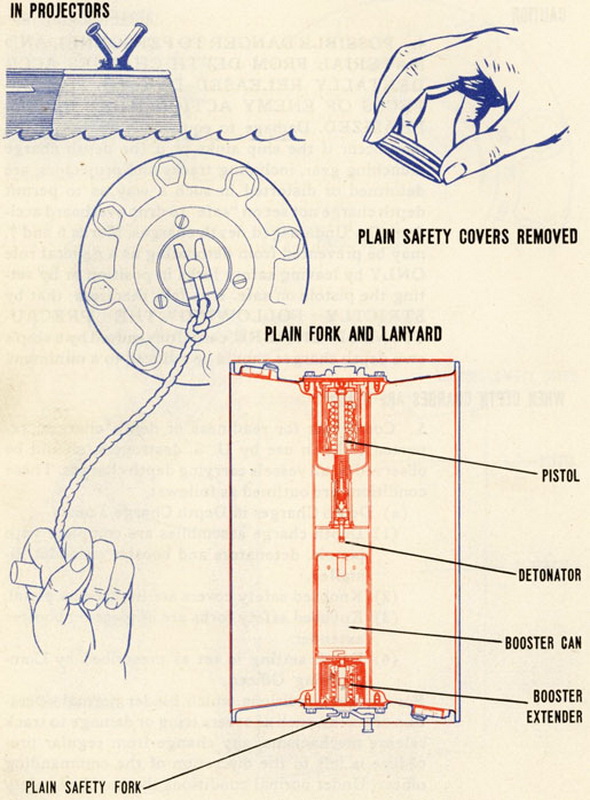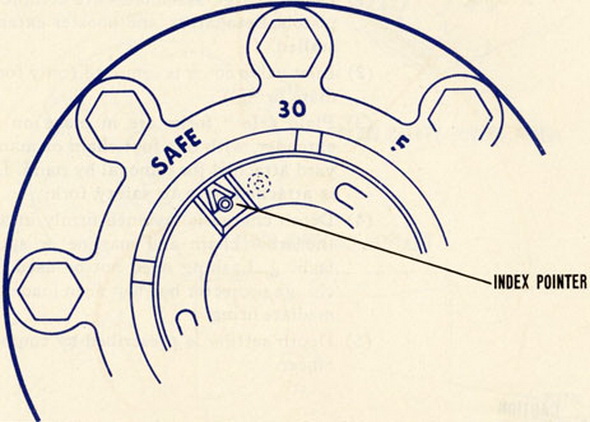|
CAUTION |
|
4. POSSIBLE DANGER TO PERSONNEL
AND MATERIAL FROM DEPTH CHARGES ACCIDENT-ALLY RELEASED DUE TO THE EFFECTS OF
ENEMY ACTION MUST BE EMPHASIZED. Dama-ge to equipment or loss of life may
occur if the ship sinks or if the depth charge launch-ing gear, including
tracks and projectors, are deformed or distorted in such a way as to permit
depth charge not set on "safe" to drop overboard accidentally. Undamaged
depth charges, Mark 6 and 7, may be prevented from detonating as a general
rule ONLY by leaving safety forks in position or by setting the pistols on
safe. It is felt, therefore, that by STRICTLY FOLLOWING THE PRECAUTIONS
GIVEN HERE, causalties caused by a ship's own depth charges should be
reduced to a minimum. |
|
WHEN DEPT CHARGES ARE READY |
|
5. Condition for readiness of
depth charges, reported to be in use by U.S. destroyers, should be observed
by all vessels carrying depth charges. These conditions are outlined as
follows: |
|
(a) Depth Charges in Depth
Charge Tracks |
|
(1) Depth
charge assemblies are complete with pistols, detonators and booster extender
installed. |
|
(2) Knobbed
safety covers are in place on pistol. |
|
(3) Knobbed
safety forks are in place on booster extender. |
|
(4) Depth
setting is set as prescribed by Commanding Officer. |
|
 |
|
Blue
indicates exterior - Red indicates
interior |
|
For certain conditions which
hinder normal operation of tracks, such as severe icing or damage to track
release mechanisms, any change from regular procedure is left to the
discretion of the commanding officer. Under normal conditions the knobbed
safety forks and cover must be stripped by the wipping plate inly and should
not be connected to the racks, or other nearby structurs. |
|
(b) Depth Charges in Y-Guns or
Projectors |
|
(1) Depth
charge assemblies are complete with pistols, detonators, and booster
ex-tender installed. |
|
(2) Inlet valve
cover is removed (only for immediate firing). |
|
(3) Plain
safety forks are in place on booster extender, with one foot chain or manial
lanyard attached for removal by hand. Lanyrad is attached only to safety
fork. |
|
(4) Depth
charge is fastened firmly in arbor by the arbor chain and marline or spun
yarn lashing. Lashing need not be used if depth charge projector has just
been load-ed for immediate firing. |
|
(5) Depth
setting is prescribed by commanding officer. |
|
CAUTION |
|
6. The chain lanyard originally
used with the Mark 6 single projector for automatic safety fork removal is
no longer advocated. Not only should this procedure be discontinued in
connection with Mark 6, but also with Mark 1 (Y-Gun) projector in order to
avoid in all cases a condition where the forces if wind, sleet, waves, or
deformations of structure to which the chain lanyrad is attached may cause
the removal of the safety fork. |
|
7. Since the safety fork may be
knocked off by explosions of flying material, compliance with the
instructions listed in paragraph 5 will not give complete assurance that the
depth charges will not explode if accidentally dropped overboard. But such
compliance will aid in maintaining a greater percentage of the safety forks
in place. With the safety fork fixed on the booster extender it is
impossible for the booster to arm. And in the event that the pistol fires
the detonator, explosion of the main charge will not result. THE POSITIVE
WAY TO GUARD AGAINST ACCIDENTAL DEPTH CHARGE EXPLOSION IS TO SET THE PISTOL
ON SAFE. It is directed, therefore, that every effort be made to set the
pistols on safe if the vessel has been struck and it is evident that
conditions are such that depth charges will not be immediately used. |
|
 |
    |